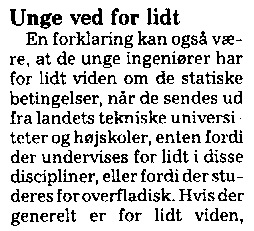
...the young engineers have too little knowledge... because of too little education, or because they study superficial.
Contemporary History (Nutidshistorie) |
| Niels Mejlhede Jensen, Bøgeløvsvej 4, 2830 Virum, Denmark. e-mail (web master) |
Link (back) to the index page.
Link (back) to the main page with the
folk dance of the week, (which may be just behind here, so you instead
only need to close this window).
| Extract from an article in the weekly paper for engineers, Ingeniøren no. 8 page 8, Feb. 25, 1994 by the associate professor and head of the council to evaluate licensed structural engineers: | |
| Stability of buildings is at hazard | |
 |
The young know too little
...the young engineers have too little knowledge... because of too little education, or because they study superficial. |
| Figures of a house for the written examination given by the above author at the Technical University in June 1992: | |
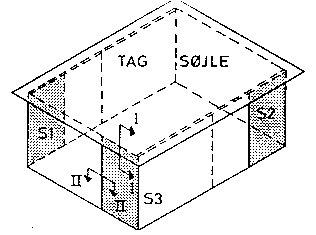 |
A house that may fall to pieces, as we shall see, if it were to be designed by the Technical University of Copenhagen, or by this council that decides if an experienced structural engineer has qualifications high enough to make design approved by the authorities. |
 |
The house covers an area of 7 x 9 metres.
The total horizontal load is here given as m in the centre of the flat roof, and there are only the two shown wall sections S1 and S2 to take this shown load down to the foundation. So any clever structural engineer can in a minute see, that this means that S1 and S2 are subjected to the same equal load = m/2, independent of whether one wall is more or less elastic than the other wall. The Technical University + the council get a total different solution, get an absurd result. (And this is in no way the achievements of modern science). |
| A simple relevant example: | |
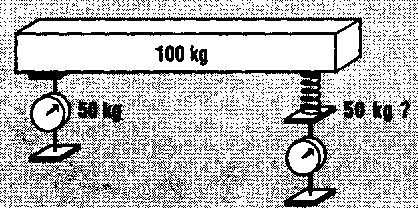 |
The problem with the uniform horizontal load from the roof delivered
to the two walls is equivalent to placing this beam of 100 kg on two scales
and measure the vertical load on the scales.
Without a spring they will both show 50 kg. So I say, and so the Technical University says. If you put an elastic spring (of no weight) below the beam (or below the scale), (and wait an hour), then the two scales will still both show the same 50 kg. So I say. (And so you say, I hope). But the Technical University says, that the scale with the spring will now get a much less load (we consider only static load). With some calculations they say, that the load here will be negative with the value of -28 kg, and at the scale in the other end without the spring will be 128 kg, as you can see in their solution below. |
| Question 1 in the written examination June 1992 for students of applied civil engineering in building structures at the Technical University in Copenhagen, extract: |
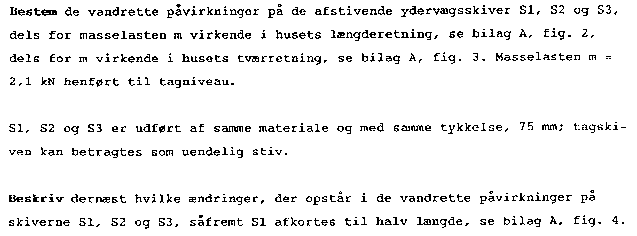 |
In short: extract relevant to here: relating to the figure 2 above,
decide the horizontal load which the roof gives the three walls, when:
|
| Official solution by the Technical University and approved by the officially
appointed external quality controller and examiner:
here I show the solution to the question with the wall S1 shortened to the half length: |
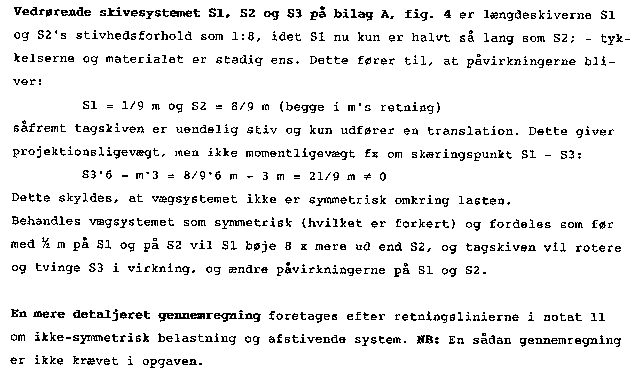 |
| In short: by shortening the wall S1 it will be more elastic as a horizontal support for the roof. |
| Next page of the official solution, with the calculations: |
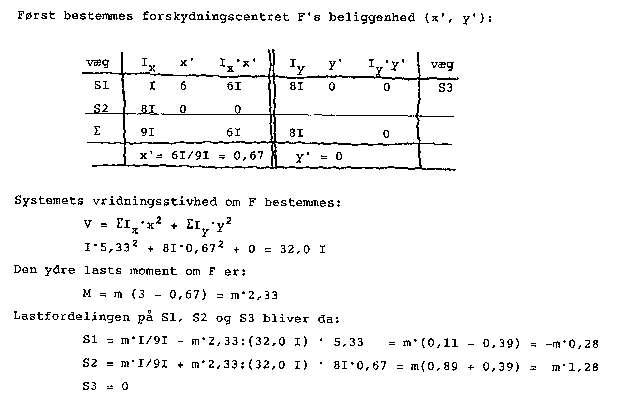 |
In short: the calculations show that the short elastic wall S1 gets
the horizontal load of a negative value:
|
This official solution to the examination is placed on the notice board
to the students right after the examination.
Some years earlier there would usually be 2 or 3 students out of about
50 that were bright enough to see the mistake. But here no one protested,
(so maybe the young engineers are as bad as described in the article above?)
But then it should be said too, that the explanation in the solution text
is so twisted and unclear, that most engineers give up. The students that
gave the correct answer got a low mark in this question. The many students
that because of poor teaching in the subject gave a wrong answer don't
need to care.
Some months later this examination example was given to the following
team of students as exercise, and by special circumstances it happened
to be me that should be the teacher teaching the example and afterwards
giving the students the written solution. I got very surprised seeing the
solution with this awkward mistake, but I thought it at the time best to
just peacefully encapsulate it before students or other teachers got to
know anything, so I right away wrote the following letter in November 1992
to the author of this fatal examination:

The letter is one page, and here I give only the extract explaining
that the horizontal loads on the two walls S1 and S2 are
equal, independent of their elasticity:

My letter is else somewhat submissive (which I regret now). I did then
not imagine, that he might still not understand that he had made a wrong
solution. To my astonishment he gave the written solution to the students
- and nothing more happened. The students were apparently not bright enough
to see the equivalent to the 100 kg beam example above.
But then I soon started to discover that several more of his examinations
were with severe mistakes, though more complicated, with this twisted way
of thinking. And this can be much more severe, because then the bright
students use much of their scarce time on trying to understand a twisted
and wrong problem.
What could I do with this misery? I then (with some excuse) asked the
Technical University (twice) for admission to the files, the archives with
the written replies from the students which the Technical University according
to rules have to file for 5 years before discarding or giving to the students.
But exactly this part of the replies was missing, for all the years.
My son had a few years earlier been a student here, a very bright student.
He graduated with the highest average for years (12,0 i 13 skalaen), and
this despite of one conspicuous bad mark - in building structures! He had
complained to me earlier about this examination. But with my new knowledge
now from the above 100 kg beam problem and its Technical University solution
I could suddenly see how wrong and twisted also his examination test had
been. It so happened that at this time it got to be 5 years since he had
the examination, so we demanded from the Technical University to get his
written reply. But exactly this part was missing in the file.
The history after this is in short:
At the June 1993 examination some students were at risk of being "squeezed"
between their education from above and the test in structural mechanics
at the main section of the institute for applied civil engineering, so
I felt obliged to start to reveal the above 100 kg beam failure problem
to other professors. But to my astonishment: this simple one minute problem
was a very complicated matter for the staff of teachers having taught for
25 years without design experience. So examinations continued as usual.
I then left the Technical University to study music theory for one year.
But occasions came up for this problem to proceed, after a journalist at
Ingeniøren gave the Technical University with its staff of professors
in structural mechanics 3 months to comment on this one problem of the
100 kg beam. I was sagged and two teams of lawyers were asked to sue me
and stop Ingeniøren. The Technical University apparently felt it
as like an offence against the royal. But the lawyers would not sue me,
and delivered a so-called responsum to Ingeniøren. I give you two
extracts here of the Technical University answer:
| Response from the vice headmaster of the Technical University in Copenhagen in Ingeniøren/Job no. 8 page 2 February 25, 1994 to my description of the above shown 100 kg beam: | |
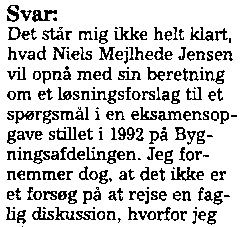 |
Answer:
It is not clear to me, what Niels Mejlhede Jensen wants to obtain with his description of a solution to a question in an examination of 1992 in the Department of Applied Civil Engineering. I feel though, that it is not an attempt to start a professional discussion... |
| Further from the Technical University response: | |
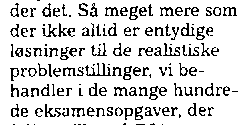 |
There is not always only one solution to the realistic problems we treat in the hundreds of examinations... |
Mistakes in examinations do of course occasionally happen in one the many examinations. But it may often be discovered though when you see the replies from the students. And is the mistake due to a normal humble and regretful teacher (as the teachers are most) then a reasonable way out should be found.
The above example shows far too bad quality control at the Technical University (and maybe at a lot of like places). Nothing has improved since then, ("because of lack of payment from the taxpayers", as the usual saying goes from the aristocracy, using slightly different words). It will not always be enough to also involve other teachers, with their narrow individual specialities. And to pay still some outside person on a high post in a council or in the private, can be of uncertain value. I propose that the examination including the official solution is submitted to the internet WWW, for anybody (young engineer) to look through.
The above mentioned council to evaluate experienced engineers' ability in structural design of buildings has become so powerful that the local authorities can decide to accept only structural design projects from their licensed engineers. (Only royal appointed town musicians were allowed to play before 1830). My nearest town hall (Holte) does not use that rule, but others do.
I have chosen to bring only short relevant translations in the extracts
above, and chosen to bring only short extracts. I could bring the complete
material, but in readable form this takes up a lot of my MB, and this gives
a big download time for you. If you are in great want of more I may bring
it, and I may translate more.
I have more to tell another day from the Technical University, (which
is owned by the taxpayers, and easily could be a better place for everybody).